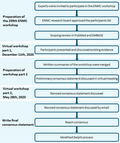- Record: found
- Abstract: found
- Article: found
European Neuromuscular Centre consensus statement on anaesthesia in patients with neuromuscular disorders

Read this article at
Abstract
Background and purpose
Patients with neuromuscular conditions are at increased risk of suffering perioperative complications related to anaesthesia. There is currently little specific anaesthetic guidance concerning these patients. Here, we present the European Neuromuscular Centre (ENMC) consensus statement on anaesthesia in patients with neuromuscular disorders as formulated during the 259th ENMC Workshop on Anaesthesia in Neuromuscular Disorders.
Methods
International experts in the field of (paediatric) anaesthesia, neurology, and genetics were invited to participate in the ENMC workshop. A literature search was conducted in PubMed and Embase, the main findings of which were disseminated to the participants and presented during the workshop. Depending on specific expertise, participants presented the existing evidence and their expert opinion concerning anaesthetic management in six specific groups of myopathies and neuromuscular junction disorders. The consensus statement was prepared according to the AGREE II (Appraisal of Guidelines for Research & Evaluation) reporting checklist. The level of evidence has been adapted according to the SIGN (Scottish Intercollegiate Guidelines Network) grading system. The final consensus statement was subjected to a modified Delphi process.
Results
A set of general recommendations valid for the anaesthetic management of patients with neuromuscular disorders in general have been formulated. Specific recommendations were formulated for (i) neuromuscular junction disorders, (ii) muscle channelopathies (nondystrophic myotonia and periodic paralysis), (iii) myotonic dystrophy (types 1 and 2), (iv) muscular dystrophies, (v) congenital myopathies and congenital dystrophies, and (vi) mitochondrial and metabolic myopathies.
Abstract
Related collections
Most cited references102
- Record: found
- Abstract: not found
- Article: not found
AGREE II: advancing guideline development, reporting and evaluation in health care.
- Record: found
- Abstract: found
- Article: found
